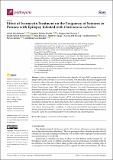| dc.contributor.author | Dusabimana, Alfred | |
| dc.contributor.author | Wafula, Solomon Tsebeni | |
| dc.contributor.author | Raimon, Stephen Jada | |
| dc.contributor.author | Fodjo, Joseph Nelson Siewe | |
| dc.contributor.author | Bhwana, Dan | |
| dc.contributor.author | Tepage, Floribert | |
| dc.contributor.author | Abd-Elfarag, Gasim | |
| dc.contributor.author | Hotterbeekx, An | |
| dc.contributor.author | Abrams, Steven | |
| dc.contributor.author | Colebunders, Robert | |
| dc.date.accessioned | 2022-06-07T10:21:31Z | |
| dc.date.available | 2022-06-07T10:21:31Z | |
| dc.date.issued | 2020-12-31 | |
| dc.identifier.citation | Dusabimana, A.; Tsebeni Wafula, S.; Raimon, S.J.; Fodjo, J.N.S.; Bhwana, D.; Tepage, F.; Abd-Elfarag, G.; Hotterbeekx, A.; Abrams, S.; Colebunders, R. Effect of Ivermectin Treatment on the Frequency of Seizures in Persons with Epilepsy Infected with Onchocerca volvulus. Pathogens 2021, 10, 21. https://doi.org/10.3390/ pathogens10010021 | en_US |
| dc.identifier.other | DOI: 10.3390/pathogens10010021. | |
| dc.identifier.other | PMID: 33396221 | |
| dc.identifier.other | PMCID: PMC7824398 | |
| dc.identifier.uri | https://repository.amref.ac.ke/handle/123456789/720 | |
| dc.description | © 2020 by the authors. Licensee
MDPI, Basel, Switzerland.
This article is an open access article
distributed under the terms and conditions
of the Creative Commons Attribution
(CC BY) license (https://
creativecommons.org/licenses/by/
4.0/). | en_US |
| dc.description.abstract | A clinical trial performed in the Democratic Republic of Congo (DRC), among persons with
epilepsy (PWE) infected with Onchocerca volvulus treated with anti-seizure medication suggested that
ivermectin reduces the seizure frequency. We assessed the effect of ivermectin treatment on seizure
frequency in PWE with and without anti-seizure medication in three onchocerciasis endemic areas
(Maridi, South Sudan; Aketi, DRC; and Mahenge, Tanzania). Pre- and 3–5 months post-ivermectin
microfilariae densities in skin snips and seizure frequency were assessed. After ivermectin, the median
(IQR) percentage reduction in seizure frequency in the study sites ranged from 73.4% (26.0–90.0)
to 100% (50.0–100.0). A negative binomial mixed model showed that ivermectin significantly reduced
the seizure frequency, with a larger decrease in PWE with a high baseline seizure frequency. Mediation
analysis showed that ivermectin reduced the seizure frequencies indirectly through reduction in
microfilariae densities but also that ivermectin may have a direct anti-seizure effect. However, given
the short half-life of ivermectin and the fact that ivermectin does not penetrate the healthy brain,
such a direct anti-seizure effect is unlikely. A randomized controlled trial assessing the ivermectin
effect in people infected with O. volvulus who are also PWE on a stable anti-seizure regimen may be
needed to clarify the causal relationship between ivermectin and seizure frequency. | en_US |
| dc.description.sponsorship | European Research Council (ERC 671055) and VLIR-UOS | en_US |
| dc.language.iso | en | en_US |
| dc.publisher | MDPI | en_US |
| dc.subject | Epilepsy | en_US |
| dc.subject | Ivermectin | en_US |
| dc.subject | Onchocerciasis | en_US |
| dc.subject | Seizures | en_US |
| dc.title | Effect of Ivermectin Treatment on the Frequency of Seizures in Persons with Epilepsy Infected with Onchocerca volvulus | en_US |
| dc.type | Article, Journal | en_US |

